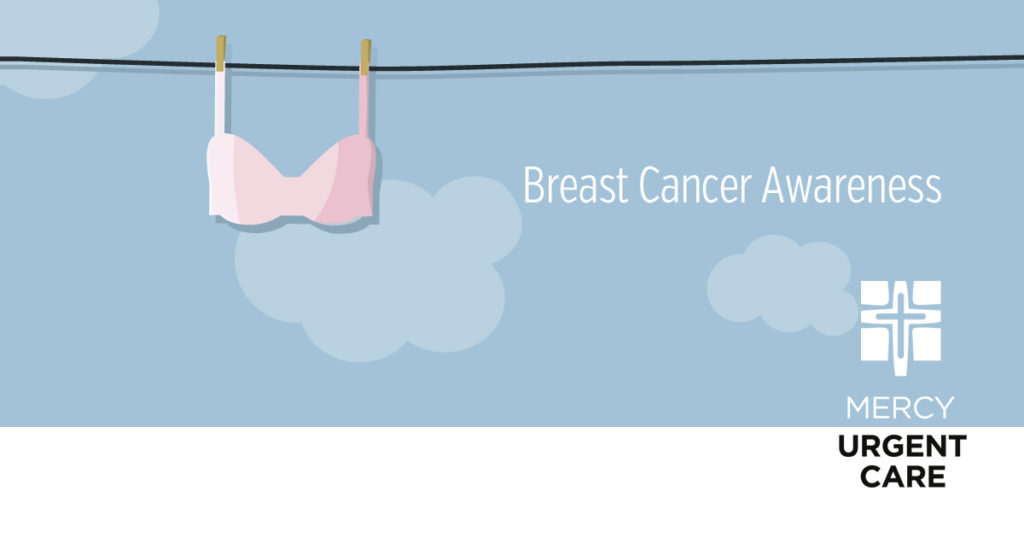 As leaves turn red, orange and yellow this October, Mercy Urgent Care is, instead, focused on pink — breaking out bright magenta ribbons, spreading information and sharing survivors’ stories for National Breast Cancer Awareness Month.
As leaves turn red, orange and yellow this October, Mercy Urgent Care is, instead, focused on pink — breaking out bright magenta ribbons, spreading information and sharing survivors’ stories for National Breast Cancer Awareness Month.
This month, Mercy wants to help spread awareness of the disease, which affects one in every eight women during their lifetimes, by providing information on everything from risk factors to early detection.
Risk Factors
Each year in the United States, more than 240,000 are diagnosed with breast cancer, and more than 40,000 women die from the disease. While no one knows the exact cause of breast cancer, there are risk factors (both genetic and environmental) that have been linked to its diagnosis.
Both men and women are at risk of developing the disease, but breast cancer occurs nearly 100 times more often in women than in men, with more diagnoses reported in Caucasian women than in those of other races. Women age 55 and older are statistically more likely to develop breast cancer, and those with a family history of breast or ovarian cancers are also at higher risk of developing the disease.
The Centers for Disease Control and Prevention recommends that women age 50-74 should schedule a mammogram every two years — and women over 40 should develop a plan with their doctors based on personal risk.
Other biological risk factors include having dense breast tissue, having experienced early menstruation (before age 12) or late menopause (after age 55), giving birth to a first child at an older age or having never given birth.
According to the National Breast Cancer Foundation, lifestyle choices and environmental risk factors include: living a sedentary lifestyle, maintaining a poor diet, being overweight or obese, drinking alcohol, having received radiation therapy to the chest before age 30 and taking combined hormone replacement therapy for menopause.
Take this opportunity, as the weather cools off, to pencil in some exercise time — enjoying Asheville’s mountain views, while also lowering your risk for breast cancer (and other preventable illnesses and health issues).
While changes to lifestyle or environment can certainly help prevent cancer, many of those diagnosed with the disease have no known link to any of these risk factors — so it’s important to stay vigilant for signs and symptoms, no matter who you are.
What to Look For
Like many cancers and other illnesses, early detection and diagnosis are key in beginning successful treatment — but this becomes tricky with often-invisible symptoms, at times undetectable without a professional medical screening.
Examining your breasts and becoming familiar with how they normally look and feel will help you identify any changes to then report to a health care professional. Breast Cancer Now, a London-based research organization, recommends examining your breasts about once a month. When performing a breast self-exam, it’s important to check the entire breast area — including the armpits and upper chest.
Lumps are often the first sign of breast cancer — and, though not all lumps are indicative of cancer, the discovery of a lump or swelling in the breast or underarm should be followed by an immediate visit to a doctor. A person with early signs of breast cancer may also notice a change in the size or shape or color of the breast, an inversion of the nipple or discharge — or a dimpling, puckering or rippling of the skin.
These symptoms don’t always point to breast cancer, but it’s important to rule out cancer as a potential cause nonetheless.
For more details on conducting a breast self-exam or on early detection, visit the National Breast Cancer Foundation website — or download and print one of its free early detection guides.
Throughout the month of October, Mercy will share the stories of breast cancer survivors. Be strong, be watchful — and know that, all year long, you have Mercy Urgent Care’s unyielding support.

